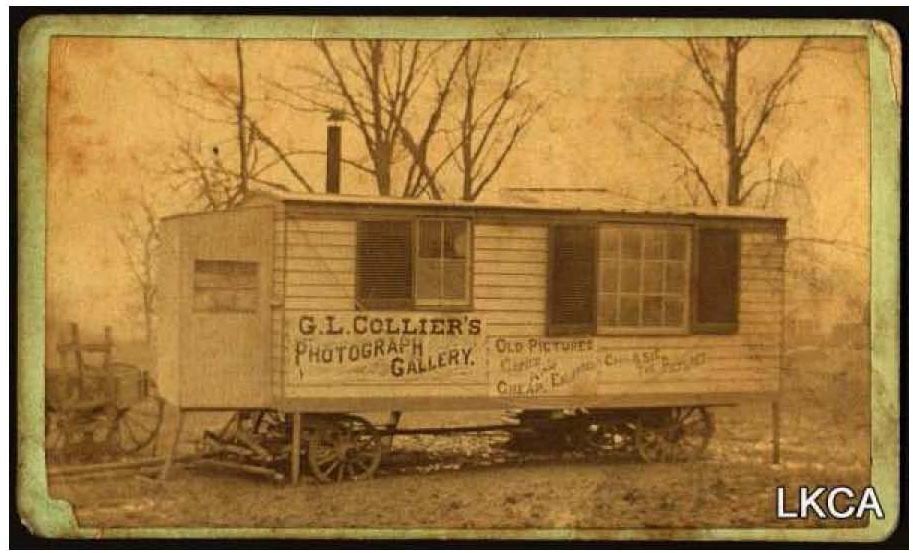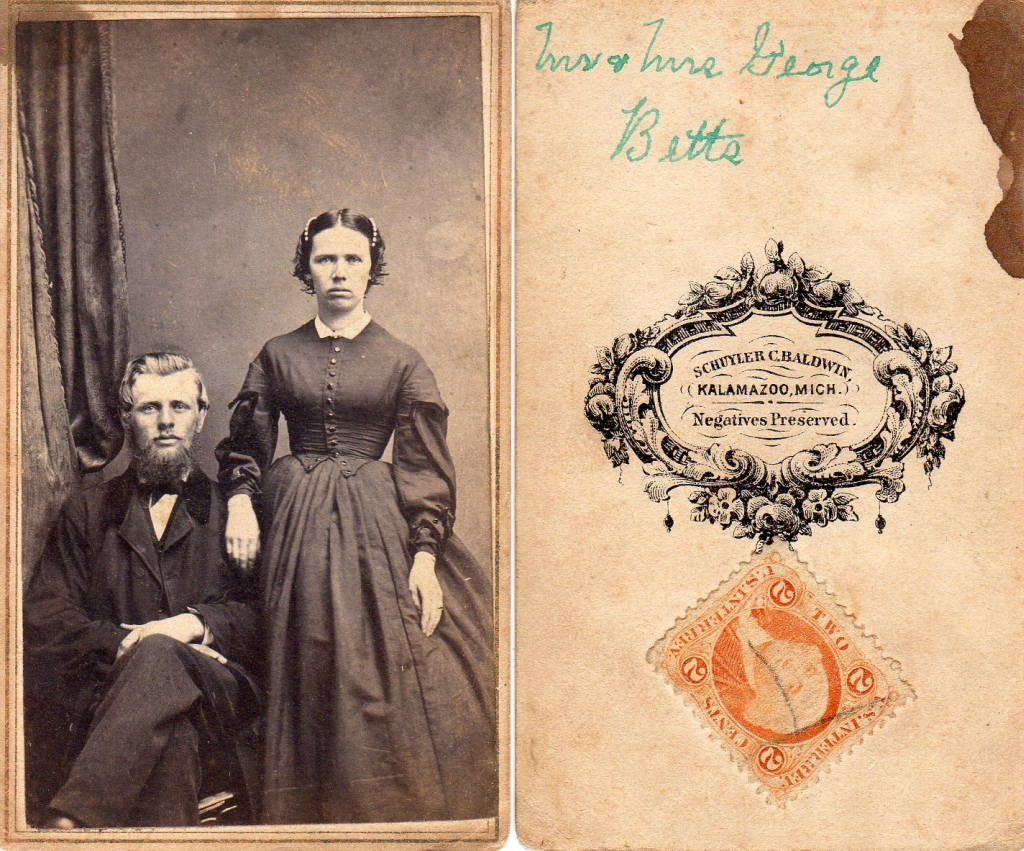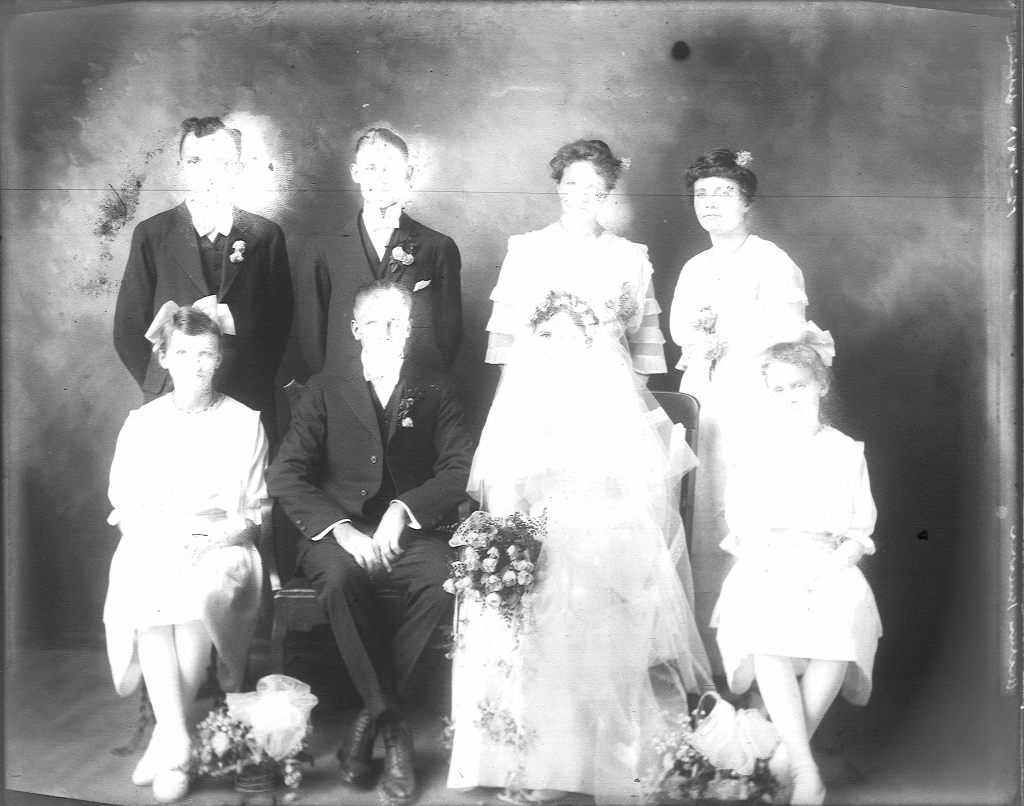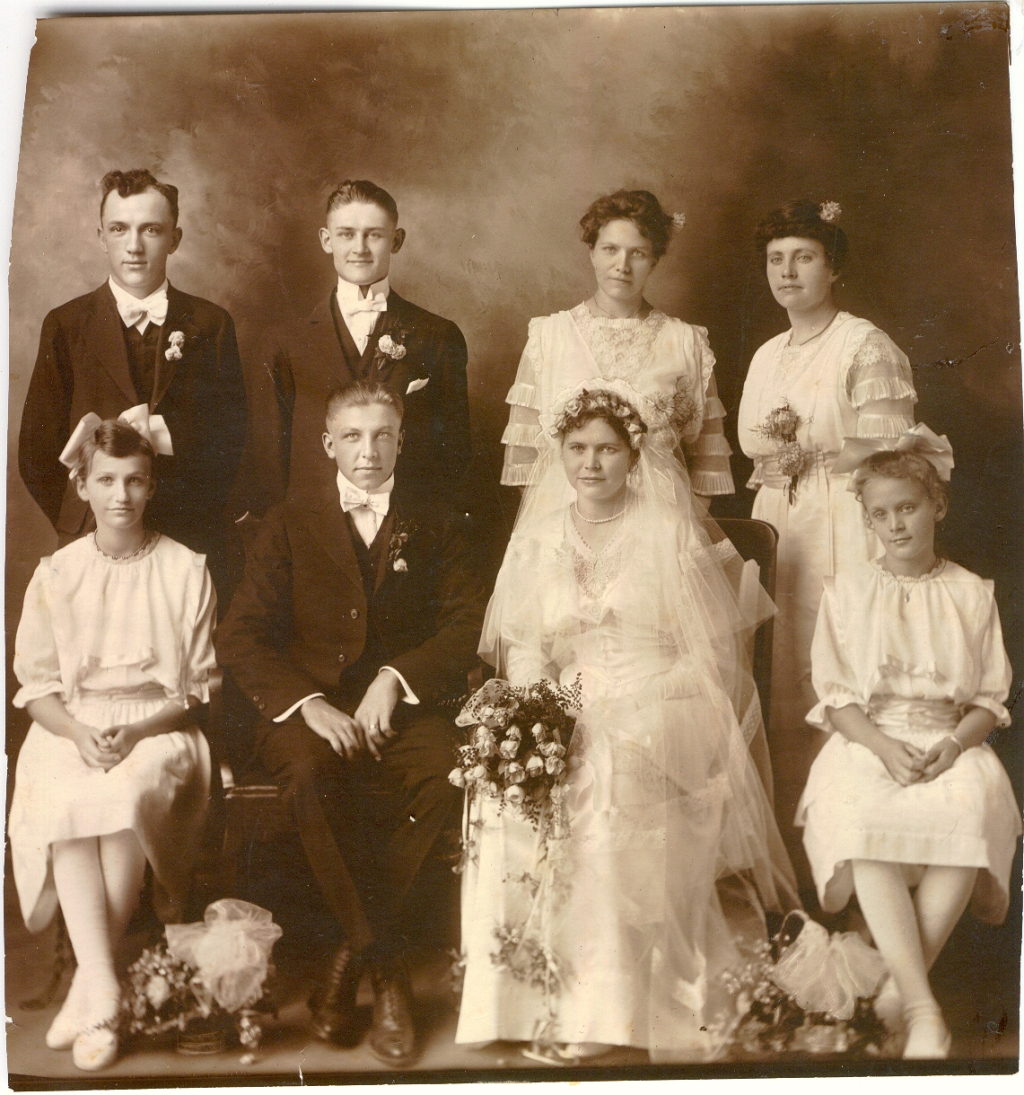 |
concordia-memories.org
Recalling Concordia's Past
|
| View previous topic :: View next topic |
| Author |
Message |
roger.pape
Site Admin
Joined: 17 Mar 2009
Posts: 414
Location: Liverpool, NY
|
 Posted: Mon Oct 03, 2011 6:57 pm Post subject: Early Photographs and Photographers Posted: Mon Oct 03, 2011 6:57 pm Post subject: Early Photographs and Photographers |
 |
|
How many early photographs do you have in your family keepsakes? A lot of good family information and memories can often be gleaned from old family photographs that may be stored in an album or shoebox. Various clues can be obtained by looking at the photo carefully, in particular if you have an original rather than a copy. One of the best references that I have found on this subject is Uncovering Your Ancestry through Family Photographs by Maureen A. Taylor.
Photography began in 1840 with the development of the daguerreotype followed about 10 years later by the less expensive but fragile ambrotype process. To protect these early photos, they where stored in folding cases. Few, if any of us, are likely to have any photos of our ancestors in these formats. By the mid-1860s, they were supplanted by the more durable tintypes. Although many of the tintype photos were also mounted in frames similar to daguerreotypes, uncased images in paper black sleeves and for albums were popular. So it is quite possible that you may find some in your archives. My maternal grandmother’s old photo album had ten of them. (See the Kappelmann-Frerking album.)
About the same time as tintypes began to appear, competing albumen prints were developed which became the photographic format of choice for portrait photos. These photos can be identified by the thin sheet of paper onto which the image was printed and mounted on a thicker paperboard stock. The first of them were called carte-de-visite (CDV) prints with an overall size of 2 1/2 inches x 4 1/8 inches. Typically, they have printing on the reverse side advertising the photographic studio. The larger sized cabinet cards (4 1/4 in x 6 3/8 in) soon followed and quickly displaced the CDV prints. If you have both in your collection, the carte-de-visite prints will generally be earlier than the cabinet cards. (Examples of both can also be found in the album cited above.)
Eventually, the do-it-yourself era of photography was ushered in by George Eastman’s introduction of the ubiquitous Kodak Brownie camera in 1900. The standard 3 ˝ in x 3 ˝ in roll film size used in Kodak cameras continued through the mid 1900s.
Dating photos –
In addition to the broad date outlines indicated above, there are various ways to date an early photograph more accurately. Some may actually have the year printed on the print or mounting. Obviously, by knowing the event being depicted (such as a wedding portrait), the date can also be established. There were a large number of photo studios in the early times that only operated for a few years in a given location. Several books have been printed that catalog all of the known photographic studios and what dates they were in business at a particular address. (Check various libraries.) A given studio may have changed their labeling over the years. So, comparing a given copy to one with a known date, you can narrow down the range. Cabinet cards are sometimes dated by the card stock (scalloped edges first appeared in the 1890s) or by the type of border.
Always look carefully at the back of the photo. Someone may have dated it. One interesting form of dating a photo might be found on the back. Between 1864 and 1866, photographers were required to affix a revenue stamp on the back of the print. The tax stamp ranged from 2˘ to 5˘ depending on the selling price. The photographer was also required to hand cancel the stamp with his/her name or initials and the date of sale. These are relatively rare, so consider yourself fortunate if you find one of these photos.
Photographer G. L. Collier –
One of the early photographers that took many of the portraits of people in the Concordia area was an itinerant photographer by the name of G. L. Collier. Earlier in his career, he operated from a studio in New Haven, MO in partnership with Charles Boley. He then started traveling around the state of Missouri in a horse-drawn wagon depicted below. He would set up shop in various town and the prints he produced would be imprinted on the back with his name and that city or simply with “G. L. Collier, Car Gallery”. Besides Concordia and New Haven, some of his photos have been traced to Troy, Clarksville, Parkville, and Columbia, MO.
The earliest record of George L. Collier was found in the 1870 federal census where he is listed as a 24 year old artist living in a boarding house in Troy, Lincoln County, MO with his 15 year old bride Adra(?). (Missouri marriage records lists the marriage of Geo. L. Collier to Adra McGuinnes in Lincoln Co. on Feb. 1 of that year.) In the 1880 census, he is listed as a 37 year old widower and photographer living in a hotel in New Haven, MO. It also lists his birthplace as Missouri, with both his parents from Virginia. A later marriage license indicates that he married Aldeah Linn in Parkville, Platte County, MO (northwest of Kansas City) on Jan. 26, 1891. However, on the marriage certificate, he listed his residence as Concordia, MO. Since several of portraits he took of Concordia area people can be dated to the mid- to late-1880s, he must have remained in Concordia for an extended period of time. Finally, an obituary in the Columbia Missouri Herald indicates that he died there on July 9, 1908. So, he appears to have moved to Columbia at the end of his career.
Other studios frequented by Concordia residents –
Prior to 1900, many of the people in the Concordia area traveled to Higginsville, MO to have portraits taken. Three of the studios were A. T. Wells, Hawkins’, and Peters Portraits In 1909, a studio was opened by A. T. Peterson who then opened an branch in the 700 block of Main St. in Concordia. In 1927, he sold the studios to Leonard Rehkop who operated them into the 1930s. Many of us have portraits with the familiar Rehkop label on the frame. Incidentally, thousands of negatives from this studio have been archived at the State Historical Society of Missouri, Columbia, MO. It also includes photos taken back to 1860 by earlier Higginsville photographers. See Rehkop Collection for more information. The photographs were organized by family and various subject areas. Scroll down through the list (there are 13 pages) and see if your family is listed.
Some people traveled to other cities for portraits. This includes studios such as C. M. Hagan in Sweet Springs; Saunders & Sons and Martland(?) in Lexington; Latour in Sedalia; Ormsby in Independence; as well as Carpenter, W. T. D’Ole, Gibson, and Grant all in Kansas City.
| Description: |
| Horse-drawn photographic studio used by G. L. Collier. |
|
| Filesize: |
80.04 KB |
| Viewed: |
30308 Time(s) |

|
| Description: |
| Revenue stamp on back of CDV. Can be dated between 1864 and 1866. |
|
| Filesize: |
779.1 KB |
| Viewed: |
16587 Time(s) |

|
Last edited by roger.pape on Tue Jan 17, 2017 10:09 am; edited 4 times in total |
|
| Back to top |
|
 |
roger.pape
Site Admin
Joined: 17 Mar 2009
Posts: 414
Location: Liverpool, NY
|
 Posted: Mon Feb 15, 2016 11:35 am Post subject: Online website to help date photos Posted: Mon Feb 15, 2016 11:35 am Post subject: Online website to help date photos |
 |
|
One website with an extensive list of photographers between 1844 and 1950 can be found at http://www.langdonroad.com/.
Check that site if you have the name of the photographer or studio.
|
|
| Back to top |
|
 |
roger.pape
Site Admin
Joined: 17 Mar 2009
Posts: 414
Location: Liverpool, NY
|
 Posted: Tue Jan 17, 2017 9:28 am Post subject: Glass Plate Photographs Posted: Tue Jan 17, 2017 9:28 am Post subject: Glass Plate Photographs |
 |
|
Glass plates were another photographic medium that was popular with portrait photographers and other serious photographers in the latter half of the 1800s and early 1900s. It was still being used as late as the 1970s. Many of the early iconic photos, such as those by Ansel Adams, were taken with them. The process was first developed by Frederick Scott Archer in 1851 but did not become practical until the 1870s when the dry plate process was developed. (See http://archives.syr.edu/exhibits/glassplate_about.html.) As noted in the posting above, the State Historical Society of Missouri microfilmed a large collection of them taken by the Peterson & Rehkop studios of Higginsville and Concordia.
While reviewing that collection, I learned a few tricks about identifying people and dates. First of all, the photographer would sometimes scratch the date and identification of the event near the bottom of the photo. This obviously simplifies the identification. However, there is another trick shown to me by Tom Tryniski, who operates the Old Fulton Postcards website. If you look carefully at the edge of the photo, usually the top but sometimes the side (depending of the dimensions), you may find an inscription made by the photographer. If it is on the back side, you will have to flip the photo in an image processing program in order to read it. This inscription (see an example below) was made when he filed the plates, usually with a serial or order number, an identifying name, and sometimes the number of copies and way it was to be mounted. In this example, it was possible to make a tentative identification of the two brothers who were soldiers in WWI. The 1910 census records and WWI registration records show two brothers, Leonard and George Witthar from Dover, MO with Leonard being seven years older than George. In other cases, by extracting the name in a wedding party photo, it is possible to find the date of the wedding in the marriage records.
A word of caution when working with old glass plate photos. One should use white gloves when handling them. You can see why from a number of photos in this collection. Notice the second example below. Fingerprint smudges are seen on the faces of various people in a group photo. My first thought was that someone was pointing out various individuals in the photos and touched the plates with unprotected fingers. However, someone suggested to me that photographers would retouch the glass plates of portraits, particularly facial features, and that the fingerprints may be a residue of this process.
Finally, these old glass plates tend to delaminate over time. So one should archive them on a more durable medium as soon as possible.
| Description: |
| Witthar brothers in WWI uniforms. [From the SHSMO Peterson/Rehkop collection, WHCM No. D1159.] |
|
| Filesize: |
730.85 KB |
| Viewed: |
16566 Time(s) |

|
| Description: |
| Inscription at rear top edge of Witthar photo. (One needs to flip the image horizontally to read it.) |
|
| Filesize: |
22.08 KB |
| Viewed: |
16566 Time(s) |

|
| Description: |
| Wedding portrait showing fingerprints on glass plate. [From the SHSMO Peterson/Rehkop collection, WHCM No. D0737.] |
|
| Filesize: |
453.22 KB |
| Viewed: |
16566 Time(s) |

|
Last edited by roger.pape on Tue Feb 21, 2017 8:21 am; edited 4 times in total |
|
| Back to top |
|
 |
roger.pape
Site Admin
Joined: 17 Mar 2009
Posts: 414
Location: Liverpool, NY
|
 Posted: Thu Jan 19, 2017 4:55 pm Post subject: Failing Memories Posted: Thu Jan 19, 2017 4:55 pm Post subject: Failing Memories |
 |
|
There are a large number of individual and group photos in the Rehkop/Peterson Collection of Glass Plate Negatives that need to be identified. I have begun the daunting task of browsing through them to see how many people and places I could identify and date, not expecting to find that many. The fingerprint smudges noted above and varying quality of the copies make it more difficult. The first picture below is an interesting example of what one encounters.
When I first saw the picture, I didn’t think there was any hope of finding out who was in that wedding party, particularly with the fingerprints on it. However, reading the label “Arthur Kuecker” on the back edge of the photo ran a bell. I had seen that picture before. My mother had that exact same picture in her collection of old photos. She was a flower girl in the wedding (left front row). Obviously, the quality of an original copy is much better than the archived copy on the microfilm, but it is still nice that so many of these photos have been preserved.
She had identified the bride as her cousin, Verna Kappelman. Checking the marriage records for the date of the wedding (which was Aug. 26,1917), there was a surprise in the record. The bride turned out to be Eleonora Riesterer, another cousin of my mother. She had remembered the wedding, but forgot which cousin was involved. (In case you don’t realize it, the memories of all of us begin to fail over the years. ) )
If you have some old family photos, be sure to identify those in the pictures. Your descendents will appreciate it. But do it sooner, rather than later!
| Description: |
| Arthur Kuecker wedding party, Aug. 26,1917. [From the SHSMO Rehkop/Peterson Collection of Glass Plate Negatives] |
|
| Filesize: |
445.05 KB |
| Viewed: |
16565 Time(s) |

|
| Description: |
| Label on right rear edge of previous photo. |
|
| Filesize: |
13.63 KB |
| Viewed: |
16565 Time(s) |

|
| Description: |
| Arthur Kuecker wedding photo. [From the Florence Frerking Pape collection.] |
|
| Filesize: |
833.7 KB |
| Viewed: |
16565 Time(s) |

|
|
|
| Back to top |
|
 |
|
|
You cannot post new topics in this forum
You cannot reply to topics in this forum
You cannot edit your posts in this forum
You cannot delete your posts in this forum
You cannot vote in polls in this forum
You cannot attach files in this forum
You can download files in this forum
|
Powered by phpBB © 2001, 2005 phpBB Group
|










